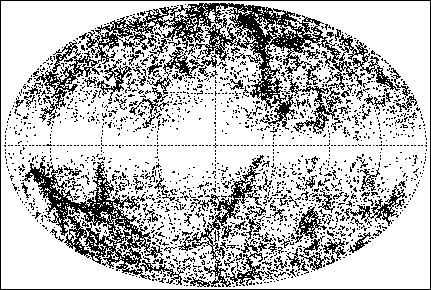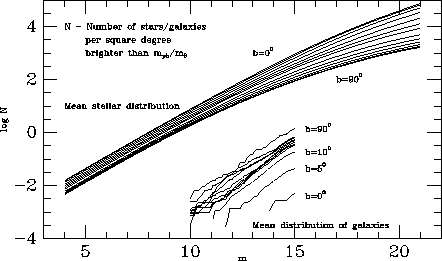
Next: An Archival System for the Observational Data Obtained at the
Okayama and Kiso Observatories. II.
Previous: HARP-The Hubble Archive Re-Engineering Project
Up: Data Archives
Table of Contents - Index - PS reprint
Oleg Yu. Malkov and Oleg M. Smirnov
Institute of Astronomy, Russian Academy of Sciences,
48 Pyatnitskaya St., Moscow 109017, Russia
The GSC (with 20 million objects, making it the biggest and most complete sky survey to date) provides accurate object positions. The NASA/IPAC Extragalactic Database (NED) contains positions, extensive data, and 1,023,000 cross-identifications for over 592,000 extragalactic objects (galaxies, quasars, and radio sources). NED currently represents the unique merger of some 40 major catalogs and many shorter listings. Catalogs and lists are being integrated into NED on a continuing basis, following a detailed cross-identification process.
Benefits of NED-GSC cross-identification are obvious for both sides. For many astronomical studies the GSC is unique; but its full potential is still out of reach. At present, the GSC lacks even rudimentary cross-identifications with other astronomical catalogs, and consequently little is known about either the nature of the objects themselves or their relationship to other data already cataloged and independently available in machine-readable form. NED can make use of the accurate positions found in the GSC.
The following general strategy is applicable to all kinds of object lists, not only those from NED. By ``source list'' we will refer to any external list of objects of a homogeneous nature (e.g., NED galaxies, NED IR sources, etc.)
These results will be provided to the maintainers of the source list or database in question.
Here we present results of Stage 1 cross-identification process for NED galaxies and NED IR sources. Note that the NED list of IR sources does not contain IR sources with an optical counterpart, e.g., galaxies. The 23% below are, therefore, IR sources with an identified GSC optical counterpart not listed in NED.

Confident cross-identifications provide an exciting possibility. If a sufficient number of source objects is confidently identified, we can expect to derive specific rulesets that describe the ``mean'' GSC representation of objects of the same type. These rulesets, coupled with object probability maps (see below), can be applied to the whole GSC in an automatic scan for unlisted objects of the same type. For example, the excellent cross-identification results for NED galaxies suggest that the GSC can yield a wealth of previously unknown galaxies. This is also suggested by two of our preliminary findings:
We also give preliminary results on cross-identification of some other types of NED objects with the GSC:
Object probability maps (OPMs) are based on the mean density of objects of a particular type at given coordinates and magnitude. OPMs can be used to estimate the probability for a given object to be of a particular type. This provides additional information on the nature of GSC objects (consider, e.g., galaxies' zone of avoidance, or the lack of asteroids at high elliptic latitudes).

Figure: Third Reference Catalogue of Galaxies (galactic coordinates,
Aitoff projection). Original PostScript figure (1.2MB).
To estimate the probability of a given object being a galaxy, we have to know both the stellar distribution and distribution of galaxies. The density of objects is approximated by the function N=N(m,b), where N is the mean number of objects per square degree brighter than m at galactic latitude b (dependence on longitude is assumed to be negligible).
For the stellar distribution, an old but still unsurpassed Seares & Joyner (1928) paper was selected. In this paper, m is given in the international photographic scale. The paper employs the old galactic coordinate system; however, the difference is not significant for our purposes.
To create a distribution of galaxies we had to evaluate available catalogs according to the following criteria: completeness in coordinates, magnitudes, sizes, etc.; large number of objects. After detailed analysis, the Third Reference Catalogue of Bright Galaxies, RC3 (de Vaucouleurs et al. 1991) was selected. It contains 23,011 objects (see Figure 1) and is complete for galaxies having apparent diameters larger than 1´ at the D25 isophotal level and total B magnitudes BT brighter than about 15.5m, with a redshift not in excess of 15,000km/s. The RC3 employs the new galactic system. The catalog has shortcomings: it is inhomogeneous, and not every object is supplied with a magnitude.
The RC3 contains 7 different magnitude bands. We selected mB, because: (i) it yields good correlation with GSC magnitudes, (ii) it is more representative in RC3 than other magnitudes, and (iii) it is close to the system used in the stellar distribution.

Figure: Stellar distribution and distribution of galaxies.
Original PostScript figure (84kB).
Only 75.6% of RC3 objects have mB magnitudes. We used six other parameters that were well-correlated (better than 0.59) with mB, to estimate mB where it was absent. This produced a total of 22,907 (99.5% of RC3) usable objects. Distributions of galaxies and stars are shown on Figure 2. This should allow us to create the required galaxy distribution by fitting the density of RC3 objects with an analytical formula.
Drs. Marion Schmitz (Caltech) and Conrad Sturch (STScI) are gratefully acknowledged for valuable advice and constant help in our work. This presentation was made possible by financial support from the Logovaz Conference Travel Program. OM is grateful to the Russian Foundation for Fundamental Researches for grant No. 16304.
Malkov, O. Yu., & Smirnov, O. M. 1995, in Astronomical Data Analysis Software and Systems IV, ASP Conf. Ser., Vol. 77, eds. R. A. Shaw, H. E. Payne & J. J. E. Hayes (San Francisco, ASP), 182
Seares, F. H., & Joyner, M. C. 1928, ApJ, 67, 24
Smirnov, O. M., & Malkov, O. Yu. 1997, this volume,
de Vaucouleurs, G., de Vaucouleurs, A., Corwin, H. G., Buta, R. J., Paturel, G., & Fouque, P. 1991, Third reference catalogue of bright galaxies (New York: Springer-Verlag)
Next: An Archival System for the Observational Data Obtained at the
Okayama and Kiso Observatories. II.
Previous: HARP-The Hubble Archive Re-Engineering Project
Up: Data Archives
Table of Contents - Index - PS reprint